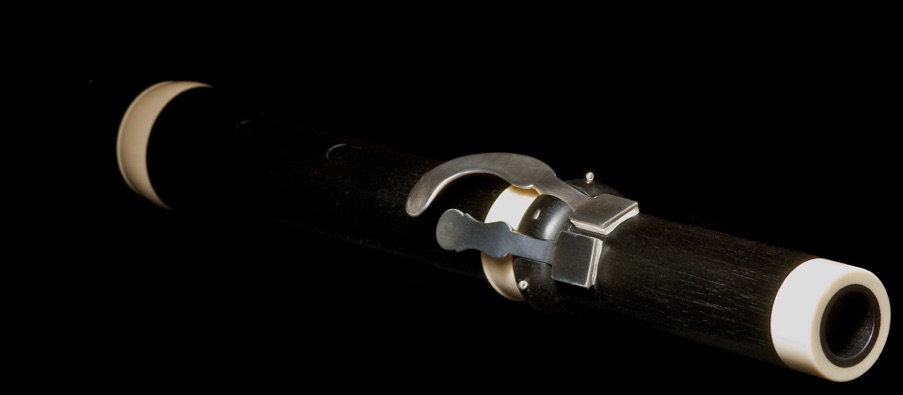

Johann Joachim Quantz, Potsdam, ca. 1745
ebony or grenadilla with two silver keys
tuning slide and screw cork
a= 392 / 405 / 415 Hz
Johann
Joachim Quantz
(1697-1773) was a flute
virtuoso, composer, and flute
teacher of Frederick the Great. With the
publication in 1752 of his „Versuch einer Anweisung
die Flöte traversière zu spielen“ („On Playing the Flute“) the
probably most important instructional work for flute was written, on par with
C.P.E. Bach‘s "Essay on the True Art of Playing Keyboard Instruments" and Leopold Mozart's "Violinschule".
Dissatisfied with current available instruments in1739 Quantz himself began to "bore and tune" his own flutes, as he wrote in his memoirs. Today eight remaining examples of his instruments are known to exist. The original, on which my copy is based, was built for his prize student, Frederick the Great. This excellently preserved ebony flute is today the property of the Musikinstrumentenmuseum in Berlin.
Among his contemporaries Quantz‘s musical taste was considered conservative, the construction of his flutes however was anything but conventional. With their extremely wide bore Quantzs flutes differ considerably from other models of the period. With the adoption of a tuning slide and screw cork innovative new standards were created. His use of separate keys for D# and Eb however - despite later used by Tromlitz - was unable to make a lasting change in flute construction. Characteristically you will find Quantz flutes with five middle joints (a= ca. 392-415) and two head joints with differently sized oval mouth holes.
Most flutists have probably read Quantz's "Versuch", but how the "clear, penetrating, thick, round, masculine, and withal pleasing sound" indeed should sound, would only with a Quantz flute first be fully realized. The player will recognize immediately why Quantz compared the sound of a flute to an alto voice rather than to a soprano. Especially in the low and middle ranges the sound is gloriously full and round. The tones above E3 however are dependant upon a good or proper embouchure, as Quantz himself wrote. The flute "speaks" with remarkable definition and clarity, therefore the use of Quantz's articulation exercises (ti-ri, di-ri, did‘ll...) becomes amazingly easy to apply. So the combination of instrument and method proves to be very exciting for the player - and for the flute constructor as well...
Amazingly, despite the wide bore, the flute plays equally well with all of the center pieces. When using the shorter middle joints, the unusually long foot joint however leads to some intonation problems with the low D. This can be overcome by using a register foot joint, although Quantz himself was not convinced of this invention. Certainly through the use of different middle joints, the sound of the flute is affected. The tone spectrum stretches from a dark saturated tone at a=392 up to a brilliant direct sound at a=415. An especially measurable balance between sonority and flexibility can be achieved through the use of the middle joint for a=405.
For the ornamental rings and the cap, I use a new material which has been specifically developed for my workshop. With its very high density it possesses similar physical qualities to real ivory.
Photo: Ulrich Ehret
Fantisek Benda
Concerto for Flute
and Strings in E minor
Allegro con brio
Marten Root
Traverso after J.J.Quantz,
a=415 Hz
De Nieuwe Philharmonie Utrecht
Fridtjof Aurin Traversos Düsseldorf


